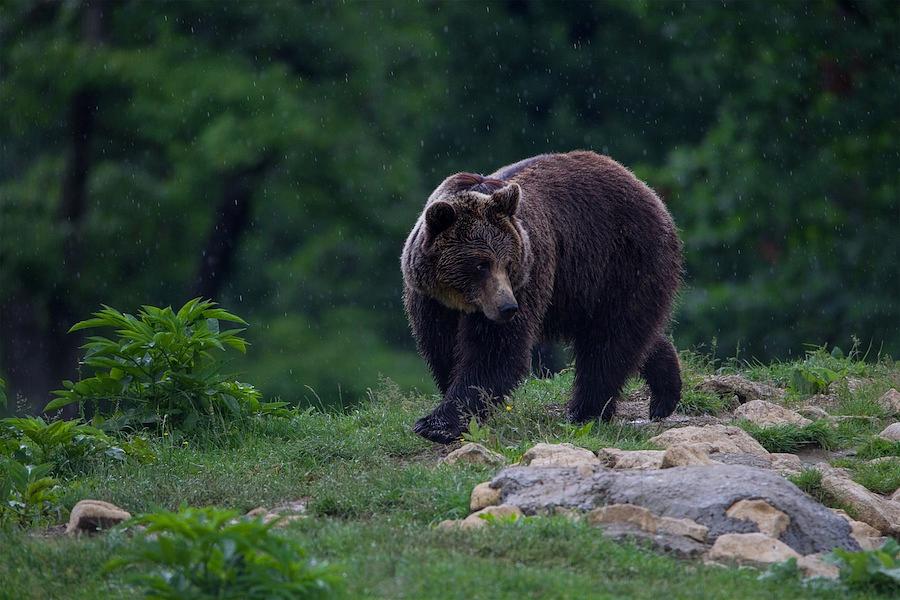Nature in the Fagaras Mountains: Romania's brown bear

Romania-Insider.com is publishing a series of articles about wildlife in Romania, zooming in on the wild animal and plant species in the Fagaras Mountains area. This editorial series is sponsored by the Foundation Conservation Carpathia.
If there is one thing Romania should be known for, besides its beautiful tourist destinations and welcoming people, that is its wildlife. The country is home to many species of wild animals, but the brown bears have always caught people’s attention.
It is believed that there are over 200,000 brown bears in the world, and estimates say that over 6,000 of them roam Romania’s forests in the Carpathian Mountains: the largest population of bears within the European Union. In Europe, the brown bear is mostly found in mountain woodlands, as they require areas with dense cover in which they can shelter by day.
Bears are among the largest living carnivores, with male bears growing to up to 350 kg and females, to some 200 kg. However, bigger bears have also been reported, including a 450 kg one in Romania.
Bears hibernate during winter, from around October/December to March/May. They choose a hibernation location such as a burrow, either on a sheltered slope under a large stone or among the roots of a large tree.
Brown bears mate from May to July. A gestation of 180 to 266 days follows, with births occurring from January to March, usually while the female is still in hibernation. Two to three bear cubs are born. Their mother would breed again 2 to 4 years later, as the cubs stay with her until three or four years old.
Bear cubs are vulnerable, being blind, naked and weighing only 340-680g at birth. But they grow quickly, reaching 25kg by 6 months. They continue lactating for 18 to 30 months while eating various foods as well.
The brown bears can reach 20 to 30 years of age, but most of them die rather early.
Their diet varies depending on the season and includes grass, roots, berries, apples and nuts, plums, as well as insects and mammals and, of course, honey. Brown bears usually forage in the morning and evening, and rest under dense vegetation during the day.
How many bears are in Romania?
This is a difficult question to respond to, as the monitoring system in Romania is not that accurate, so the exact number of bears remains unknown. A 2014 census showed that there are between 6,000 and 6,300 bears in the Romanian forests. But how reliable are these numbers?
A reliable way to count bears would be through genetic analysis. This would mean collecting bear feces or hair and then taking the samples to a special lab for analysis, to reveal the bear’s DNA. The number of bears in the country can be closely approximated based on this scientific data analysis. This system is used in countries such as Slovenia and Croatia, as well as the Scandinavian countries.
However, Romania has a different way of counting its bears, which some consider arguable. Hunters are the ones in charge of counting the bears and making reports, which they submit to the regional Forest Guards. From there, during the last years, the Wildlife Department of the University of Transilvania in Brasov, a mountain resort in central Romania, has summarized the collected data and submitted a report to the Ministry of Environment.
How do hunters estimate the bear population? They go out to man-made feeding places and count how many bears come there, as well as look for bear tracks. But nobody can tell for sure if a bear coming to a certain place wasn’t already counted at another feeding spot or if there are bears that never go to these feeding places, so this is more of a general estimation.
Some might come to believe that the figures are actually mirroring more the hunters’ interest, than the real situation. How come?
Bears are protected species by international and Romanian laws. This means that regular bear hunting for sport or trophy is not allowed in Romania. However, bears can be killed here in certain cases, but only if the Minister of Environment issues a ministerial order. For example, if a bear causes serious damage or poses threats to the population, the minister can issue a killing permit. While this may seem like a reasonable situation, the trophy hunting industry usually wants to play a part in this killing, as big money can come out of it, according to pundits.
Last year, Romania's Minister of Environment issued dozens of killing permits, but the process was not very transparent, so nobody really knows how many bears were actually shot, how they were shot, or if these permits were wrongly used for trophy hunting.
Why do bears go out of forests?
Bears usually leave the forests to search for food. For example, last fall, they couldn’t find enough beechnuts or acorns in the forest so they had to find food somewhere else. The logging activity also sends bears away from the forests because of the noise. They can thus end up in areas closer to villages or other populated areas. The irresponsible expansion of tourist or residential areas also affects the bears’ natural habitat.
Regardless of the reason, bears are wild animals and they can cause damage. Specialists argue that killing them shouldn’t be the first and too often only answer to this problem. The authorities should take measures that can keep safe both the people and the wild animals.
What can you do to stay safe?
Bears get used to food resources fast, so if they learn that there is food around houses or in a specific place, some of them will continue to go there. If you live close to bear habitats, don’t leave waste around the house. You can use bear-proof containers.
If you meet a bear in the forest or near a populated area, stay calm, don’t get close, and slowly go backward. Bears are usually not interested in attacking people, but they can get violent if, for example, you get too close while they are feeding. People should accept bears are strong, powerful animals and stay away if they are feeding. Always keep away from a mother bear with cubs.
How can Romania make money from bears without killing them?
The answer to this question is tourism. Bears can be an important tourist attraction, as many people want to see them or photograph them in their natural habitat and are willing to pay good money to do that. Unfortunately, there are only a few proper locations for bear watching in Romania, although this would be a good way to attract foreign tourists to the country.
Sources consulted for this article: World Wide Fund Romania; Christoph Promberg - Fundatia Conservation Carpathia.
Irina Marica, irina.marica@romania-insider.com
Photo source: Adobe Stock
This article is part of the "Nature in the Fagaras Mountain" editorial series, currently sponsored by Foundation Conservation Carpathia.
 The foundation, in partnership with neighboring hunting associations, is currently working in a 100,000-hectare area of the eastern Fagaras Mountains, trying to establish a system of genetic analysis for bears.
The foundation, in partnership with neighboring hunting associations, is currently working in a 100,000-hectare area of the eastern Fagaras Mountains, trying to establish a system of genetic analysis for bears.















